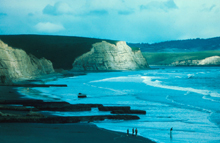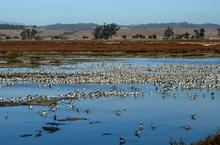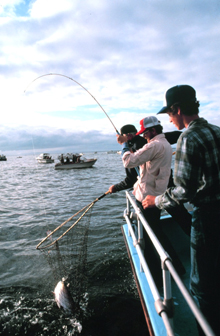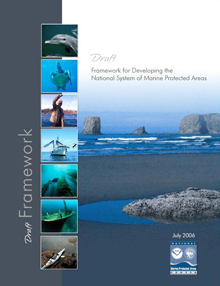Marine Protected Areas: Evolving Efforts to Manage Marine Resources
While marine protected areas (MPAs) have been used to protect marine resources for centuries, interest in how they can contribute to ensuring healthy oceans for future generations has grown over the past 10 years. NOAA and other federal, state, and local partners are working to develop a scientifically based, comprehensive national system of MPAs representing diverse U.S. marine ecosystems.
- Introduction
- Laying the Groundwork
- Presidential Action
- Continuing to Move Ahead
- Conclusion
- Works Consulted

Marine ecosystems and organisms, such as this anemone, can be protected within special marine areas. Click image for larger view.
You don’t have to live near the ocean to appreciate the many services and benefits humans and marine resources derive from a healthy ocean environment. Similarly, it is difficult to ignore that many human activities also impact our oceans, both economically and ecologically. Whether you are a fisherman, a diver, a kayaker, a farmer, a resident of a coastal community, or you just love the ocean, you recognize that our marine resources need to be protected for current and future generations.
Marine protected areas (MPAs) in the U.S. come in a variety of forms and are established and managed by all levels of government. There are marine sanctuaries, estuarine research reserves, ocean parks, and marine wildlife refuges. Each of these sites differs. MPAs may be established to protect ecosystems, preserve cultural resources such as shipwrecks and archaeological sites, or sustain fisheries production.
This article traces actions taken by NOAA and federal, state, and local partners over the last decade to step up U.S. efforts aimed at effectively using MPAs to manage marine resources.
(top)Laying the Groundwork: The Late 1990s
MPAs have been established and managed around the world for decades. In the past 10 years, however, interest in how MPAs can be integrated into marine resource management plans has increased substantially.
A Scientific Consensus
In 1997, at a conference of the American Association for the Advancement of Science, a symposium on MPAs featured the future of the oceans, unresolved ocean science issues, and marine research priorities. The result of this symposium was the formation of an international group of scientists, who discussed MPAs and related science over the next few years. In 2001, this group issued a consensus statement calling for a unified approach to understanding the science behind MPAs. The statement was signed by 161 scientists.
Recognizing the Benefits of MPAs

Areas such as Drake's Beach in the Point Reyes National Seashore provide a meeting place for land and sea. Elephant seals have just recently started to recolonize this area. Click image for larger view and image credit.
At the National Ocean Conference in 1998, the United States celebrated the international year of the ocean and worked to form a common vision for the future of the ocean. A wide range of people interested in ocean issues, including representatives of academia, business, and industry; public interest groups, including environmental and other non-profit interests; and state, local, and federal government officials, including NOAA, attended this conference.
Marine protected areas were of particular interest to many conference participants. They drafted a discussion paper describing how MPAs can be an effective management tool for conserving living resources and the habitats on which they depend. The paper listed the benefits of MPAs, including:
- protecting biodiversity and unique or significant resources;
- providing a living laboratory to study and test management effectiveness;
- attracting revenue-generating tourism activities;
- enriching a critical link among nations’ food supplies; and
- providing potential future benefits from marine biotechnology.
Presidential Action
A turning point toward improving the coordinated, comprehensive use of MPAs in the U.S. came in 2000, when the Marine Conservation Biology Institute and the Cousteau Society called on President Clinton to establish a science-based system of MPAs to protect the nation’s marine ecosystems, along with other management tools.
This push to take additional action to preserve the nation’s marine resources resulted in Executive Order 13158, which calls for “…a scientifically based, comprehensive national system of MPAs representing diverse U.S. marine ecosystems, and the Nation’s natural and cultural resources.” The Executive Order, signed in May 2000, called for the establishment of a National Marine Protected Areas Center and an MPA Federal Advisory Committee.
President Bush’s U.S. Ocean Action Plan, released in 2005, outlines a variety of actions for promoting the responsible use and stewardship of ocean and coastal resources for the benefit of all Americans. In relation to MPAs, the Ocean Action Plan emphasizes greater scientific and programmatic coordination between ocean agencies, including coordination of those activities called for in the MPA Executive Order.
Today: Continuing to Move Ahead
Currently, over 100 federal, state, territory, and tribal agencies manage more than 1,500 marine areas across the country. NOAA is responsible for the management of dozens of MPAs, including national marine sanctuaries, national estuarine research reserves (managed in partnership with states and territories), the new national monument in the Northwest Hawaiian Islands (managed with the Department of the Interior), and many fishery management areas (managed in partnership with regional fishery management councils).
Managing the nation’s MPAs is truly a partnership effort among associated agencies. NOAA uses its resources and expertise in ocean, ecosystem, and fisheries management to provide leadership on many of these efforts, from establishing and effectively managing areas to leading the development of a national system of MPAs.
Defining Today’s MPAs
While several efforts have pushed MPAs into the limelight, there is confusion and debate regarding what the term “marine protected area” really means. Some people interpret MPAs to mean areas closed to all human activities, while others interpret them as special areas set aside for recreation (e.g., national parks) or to sustain commercial use (e.g., fishery management areas). These are just a few examples of the many types of MPAs.

MPAs come in all shapes and sizes. Here, birds congregate along Elkhorn Slough harbors, the largest tract of tidal salt marsh in California outside of San Francisco Bay. Click image for larger view.
In reality, “marine protected area” is a term that encompasses a variety of conservation and management methods in the United States. If you have been fishing in central California, diving a shipwreck in the Florida Keys, camping in Acadia, snorkeling in the Virgin Islands, or hiking along the Olympic Coast, you were probably one of thousands of visitors to an MPA.
In the U.S., MPAs span a range of habitats, including the open ocean, coastal areas, inter-tidal zones, estuaries, and the Great Lakes. They also vary widely in purpose, legal authorities, agencies, management approaches, level of protection, and restrictions on human uses.
The National MPA Center
The National MPA Center, established in 2000, is housed within NOAA and coordinates MPA activities across federal and state agencies, territories, and tribes through the development of the national system of MPAs. NOAA leads the efforts of the MPA Center in partnership with the Department of Interior, which also manages many MPAs.
Through the MPA Center, NOAA is able to contribute its resources and expertise in oceans, ecosystems, and fisheries management—critical components of MPA coordination. NOAA delivers MPA information, analyzes MPA science and policy issues, and provides technical assistance to managers on the effective use of MPAs.

Many MPAs are open for recreational uses, such as fishing. Click image for larger view.
Because MPAs can be a controversial and complicated topic, the MPA Center serves as an information source for the public and various user communities. The MPA Center recently completed an initial, comprehensive inventory of the nation’s marine conservation areas in federal and state/territorial waters. It also developed a classification system for MPAs in the U.S., to break down and explain the many types and purposes of MPAs.
The MPA Center is also a resource for social, cultural, and natural MPA science. The MPA Center Science Institute, in Monterey, California (co-located with the NOAA Fisheries lab in Santa Cruz, California), plays a key role in developing research strategies, supporting research on MPA issues, and assessing key science issues fundamental to the use of MPAs as a conservation and management tool.
Establishing a Framework

In 2006, the MPA Center released a draft framework for developing the national MPA system. The final framework is expected to be finalized in late 2007. Click image for larger view.
In September 2006, the MPA Center released and requested public comments on a draft framework for developing the national MPA system. This framework was the result of a series of nationwide public meetings with government partners and a variety of stakeholders over more than two years. It provides common sense guidance for collaborative efforts among federal, state, tribal, and local governments and stakeholders to work together to improve the use of MPAs in the conservation and sustainable use of the nation’s natural and cultural resources. The framework outlines flexible mechanisms for supporting activities that strengthen the effectiveness of existing MPAs and improve the science foundation for identifying new areas.
The public is invited to review the framework and provide comments directly to the MPA Center. In late 2007, the document will be finalized. The next step will be the formation of the national MPA system, beginning with existing sites.
Conclusion
Marine protected areas are an important tool for ocean management that, when used effectively, contribute to healthy oceans for our future. They provide recreation and economic opportunities for millions of Americans. MPAs help sustain critical habitats and marine resources for future generations and act as an “insurance policy” by helping to protect marine resources from human impacts or natural events.
Through efforts over the past decade, the United States has taken significant steps toward a coordinated strategy to understand the ecological and human connections, jurisdiction, and the public’s role in managing the diverse range of MPAs. With its partners, the National Marine Protected Areas Center is working to develop the national system of MPAs.
Once the national system is in place – sometime in 2007 or 2008 – the nation will have a structure in place to more effectively manage our spectacular range of special places in the sea.
Works Consulted
American Association for the Advancement of Science. (2001). American Association for the Advancement of Science consensus statement. Retrieved October 11, 2006, from http://www.jiwlp.com/contents/Marine_Reserves_Report.htm or http://www.nceas.ucsb.edu/Consensus/consensus.pdf.
Marine Conservation Biology Institute. (2000). Marine Conservation Biology Institute calls for Presidential Action. Retrieved October 11, 2006, from http://www.mcbi.org/what/mpa_exec.htm.
National Marine Protected Areas Center. (2006). Draft Framework for Developing the National System of Marine Protected Areas (September 22, 2006). Retrieved October 11, 2006, from http://mpa.gov/national_system/pdf/final-framework-draft.pdf.
National Marine Protected Areas Center. (2006). National Marine Protected Areas Center Web site. Retrieved October 11, 2006, from http://www.MPA.gov.
NOAA. (1998). National Ocean Conference (June 11-12, 1998), Archived Web site. Retrieved October 11, 2006, from http://www.yoto98.noaa.gov/oceanc2/.
Executive Order 13158 on Marine Protected Areas. (May 26, 2000). Retrieved October 18, 2006 from http://mpa.gov/executive_order/execordermpa.pdf.
U.S. Ocean Action Plan. (December 17, 2004). Retrieved October 18, 2006 from http://ocean.ceq.gov/actionplan.pdf#
search=%22us%20ocean%20action%20plan%22.
